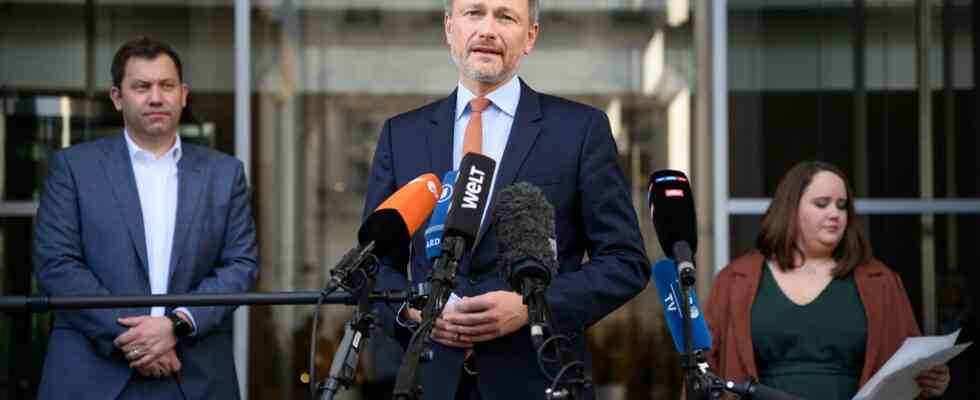analysis
Status: 03/24/2022 3:51 p.m
The Berlin coalition is reacting to the drastically increased energy prices with another relief package. But who is supposed to pay for all this? And why is the finance minister going along with this?
What kind of pictures were they after the federal elections: the selfie of the FDP and the Greens, the joint walk of all traffic light giants along the Spree to present the coalition agreement. All of this promised a new political style – after the last little constructive cooperation between the Union and the SPD in the grand coalition.
According to the message, differences do not necessarily have to lead to disputes; rather, different positions can complement each other. Olaf Scholz promised that they did not want a policy of the lowest common denominator, but a policy of great effect.
Menacing aftertaste
With the relief package II, these words get a financially threatening aftertaste. It was obvious that the traffic light partners from the SPD, Greens and FDP entered the talks with very different ideas. The FDP with the aim of relieving motorists as quickly as possible, that’s what Christian Lindner’s “tank discount” stood for, which was not well received by the coalition partners.
Especially not with the Greens, because they are actually in favor of increasing the price of fossil fuels, so from their point of view, easing the price of petrol is downright counterproductive (even if the current price jumps go too far for the Greens, of course). And then there is the SPD, which also wants to relieve “the broad middle of society” – an expression that the FDP and Union have successfully introduced into the debate in the past few days – but it just has to be designed in a socially just manner.
Winners only
These differences have in fact become an addition: instead of forging compromises where everyone has to do without something, the relief package II has become a big cornucopia with something for (almost) everyone. Above all, however, for the traffic light partners themselves, who can all feel like winners.
Who should pay for the whole thing remains open. It is not even certain how much the new relief package will cost. It could be about as much as the first relief package, says Finance Minister Lindner. It was about 13 billion euros, which flow, for example, into the early abolition of the EEG levy on electricity prices and a higher basic tax allowance.
Twelve billion euros gross
But these 13 billion should easily be topped by the new package. The subsidy of 300 euros for all employees is particularly important. With more than 40 million people in work, that alone amounts to twelve billion euros gross. As a qualification, the 300 euros are subject to tax, which varies according to personal tax rate; the bottom line is that the state pays less or less reaches the taxpayers.
Then the relief when refueling via the energy tax. With an annual consumption of around 45 billion liters of fuel and a reduction in the price of petrol by 30 cents or the price of diesel by 14 cents for three months, government subsidies of around three billion euros will result. Those who drive more or have to drive more benefit from it in particular. Since gasoline use statistically increases with income, many economists have previously criticized such a simple price cut – it helps the rich more than the poor.
Coalition agrees on relief package
Julie Kurz, ARD Berlin, daily news at 2:00 p.m., March 24, 2022
Child benefit surcharge
In addition, there is the surcharge for child benefit – that should be around 1.5 billion euros. There are no calculations for the discounted local transport ticket yet. In the end, however, the package should be more like 20 billion euros than the 13 billion mentioned by Lindner – money that the federal government does not have, which can only be financed by further debts in the announced supplementary budget.
One could ask why an FDP finance minister, who has regularly committed himself to sound budgetary management, is going along with this. One answer that goes beyond the upcoming state elections could be that Lindner already has an eye on the coming year.
He is now waving through all expenditures that are limited and that are due this year because the federal government is tearing the debt limit of the Basic Law anyway. Visually, this will make the 2023 budget look much better than the 2022 budget – here you can still refer to the consequences of Corona and the Ukraine war.
Kristin Schwietzer, ARD Berlin, on the coalition’s relief package
tagesschau24 extra 4:00 p.m., 24.3.2022
Higher taxes in the future
In the medium term, however, higher debt today means higher taxes in the future. Especially when the debt is not used to finance investments, but rather consumption, as is the case with the new relief package. Other measures designed to ensure energy efficiency and the expansion of renewable energies, on the other hand, are designed for the medium term.
Economists have found that the level of government spending correlates with the number of coalition partners: the more parties in a government, the more spending is made to serve each party’s clientele. As a result, the amount of national debt regularly increases with the number of coalition partners. To what extent this also applies to the traffic light coalition cannot be said after these first 100 days, which were marked by crises. But it should be a reminder.

